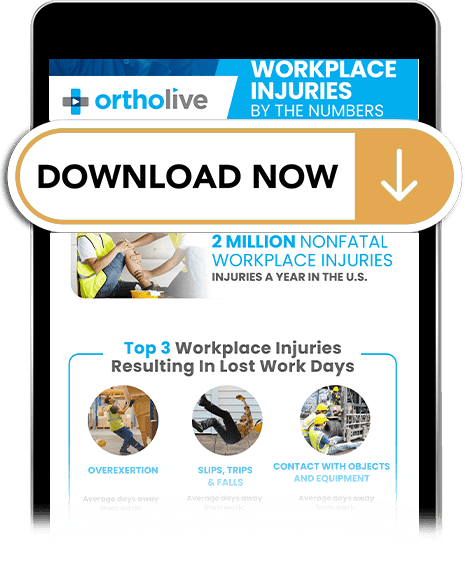
The American workplace can be full of hazards and bad habits leading to countless musculoskeletal injuries among employees. Not only does this affect the lives of these workers, but employers rack up over $171 billion in employee injury costs each year.
What can employers do right now to keep employees safe, prevent these injuries, and reduce their musculoskeletal spend? This blog explores the topic of employee safety and provides 7 steps to keep employees safe at work.
Why Does Employee Safety Matter to Your Business?
Keeping your employees safe is both a moral and financial imperative for your business. Even with the rules governing safety standards today, injury and even deaths are all too common in the workplace. The latest workplace injury statistics show:
- U.S. companies spend more than one billion dollars every week on workplace safety incidents
- Even the smallest companies still experience 1.2 on-site injuries per 100 workers every year
- For every $1 spent on the direct costs of dealing with a workplace safety incident, there are another $2.12 lost on indirect costs
- Every 99 minutes, someone dies just trying to do their job
Even more sobering is that you don’t have to work in a hazardous environment to experience a workplace injury. Chronic injuries from repetitive physical tasks can be as close as your nearest computer.
In fact, employers spend more on musculoskeletal disorders than any other type of chronic disease. Chronic joint injuries caused by work conditions are more costly than diabetes, obesity, and respiratory illnesses. Workplace musculoskeletal ailments are the top causes of OSHA recordable events. The causes of these injuries include:
- Straining muscles or overexertion
- Falling at work
- Being struck by an object
- Slipping and tripping
Given the numerous hazards that can exist at a jobsite, and the high risk of developing chronic injuries, how can we continue to keep our workers safe?
What Are the Seven Steps to Keeping Workers Safe?
The numbers alone call for increased scrutiny of job site safety in your workplace. The benefits aren’t just financial. Employees will be more productive if they feel safer on the job. It will even positively affect employee retention. These realities suggest that the following seven workplace safety initiatives will quite literally pay for themselves.
1. Allow for remote work arrangements when possible
Let’s address the COVID elephant in the room, first. OSHA still recommends basic safety measures to protect your workforce from spreading the virus. This includes:
- Encouraging employees to get vaccinated
- Instructing employees exposed to the virus to stay home
- Perform routine disinfection and cleaning
- Practicing social distancing and mask-wearing
But many companies have also decided to keep their workforce home to protect their employees while also continuing operations. While this isn’t always possible, many companies have shifted to remote work whenever possible to help protect their employees. While the numbers vary, some estimates put the current work from home numbers at nearly 60% of the U.S. workforce.
2. Perform regular risk assessments of the workplace
For on-site workers, it’s important to conduct regular safety audits of their day-to-day job site conditions. There are all kinds of hazards associated with daily job site tasks, but this should include observation of manual activities that require carrying or lifting. These conditions can change in the workplace, creating a moving target for safety that you must continually strive towards.
Conducting regular risk assessments will not only improve worker safety—it will help you survive your next OSHA audit.
3. Define safety standards for every position in your business
Every job carries its own risks. Make it a best practice to develop safety standards each time you create a new job description. There are minimum safety standards across your business. For example, protocols for the disposal of hazardous wastes or shut-down procedures for equipment. But there are also specific safety requirements for each job. Give some thought to what they are, how you teach, and how you enforce them.
4. Talk and train about safety
Every new employee in your business should have safety training. However, this shouldn’t be a one-time event. As OSHA regulations change, as you adopt new equipment, when you bring on temporary or seasonal help—all of these are opportunities to bring the topic of worker safety to the forefront of your business.
The idea is to create some muscle memory, in some cases literally, about the kinds of steps necessary to keep each other safe.
5. Provide the right gear
Did you know the majority of head injuries stem from not wearing protective safety gear? Wearing personal protective equipment (PPE) is as important as operating equipment safely. When both happen simultaneously, the worker is automatically just a little safer on the job. Each type of PPE is geared for specific job risks.
To ensure that your workforce is wearing the right gear, it’s good to train your employees in why the equipment is necessary. From safety glasses to harnesses, hard hats, cut-proof gloves, and more, all can be necessary under the right set of circumstances. Don’t skimp on providing your employees with these resources. It’s an investment that will pay you back in the long-run.
6. Develop an ergonomics plan for your business
Repetitive muscle strain injuries affect more than 1.8 million workers every year. That’s a big chunk of your workers’ compensation costs. There’s big risk in developing musculoskeletal issues related to repetitive lifting, forceful hand or arm movements, or maintaining awkward positions for long periods on the job.
Creating an ergonomics plan for your business can reduce some of these concerns. For example, training your workforce in how to lift properly, providing fatigue mats to walk on, or offering stand up desks can help cut down on these injuries.
7. Establish an on-site injury assessment workflow
The last line of defense when attempting to reduce on site work injuries is to create a way to assess an injury immediately when it occurs. In the past, most injuries, no matter how minor, would end up in the hospital ER for assessment. Companies simply don’t have healthcare personnel on site 24/7 to provide this service.
That’s one of the reasons why today, telemedicine can bring a clinical professional right to the injured worker via their mobile device.




